Your Cart is Empty
Spring Sale! Shop Now > |Free USA Shipping On Orders Over $75!
Spring Sale! Shop Now > |Free USA Shipping On Orders Over $75!
Spring Sale! Shop Now > |Free USA Shipping On Orders Over $75!
Spring Sale! Shop Now > |Free USA Shipping On Orders Over $75!
by Kelley Hobart June 19, 2014 3 min read
Each year we shear our alpacas and harvest their fiber to make into alpaca roving for our customers. Our animals have been carefully chosen for their fiber quality, color and great personalities. As the summer heats up, it is important to remove the fiber so each alpaca can stay cool and comfortable.
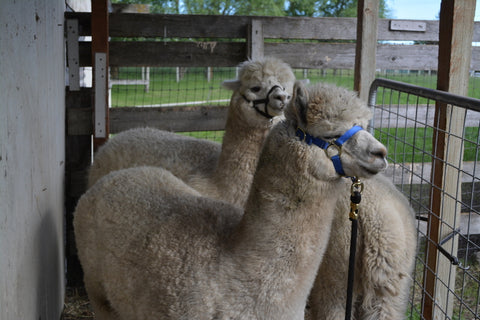
Alpacas waiting to be shorn
During shearing we separate the fiber into 3 bags for each animal. The blanket is the "1st" fiber, the neck and belly are "2nd's" and the legs are "3rds" On our ranch, we process 1st and 2nds while using 3rds for felting and other craft projects. This means the softest, cleanest fibers are used to produce our rovings.

The first step on the way to roving is called sorting where we inspect the each fleece, clean out debris and properly classify the fiber with each animal. We then skirt the fiber on a skirting rack by laying each fiber on the rack and allowing hay and vegetation to fall through the rack. We again inspect the fibers and bag and tag each skirted fiber based on the quality grade and name of the animal it came from.
We are fortunate to have a fiber processing mill just 15 minutes from our ranch and store. The mill is run by Karen Goodson of Fibers First and she is a long-time fiber enthusiast who does a great job turning our fleece into roving. Fibers First is a local, family run business here in Northern Idaho.
Some of the machinery they are utilizing was manufactured at the turn of the 20th century! Before the fiber can be fed into the machine it needs to be washed and dried to remove as much dirt and debris as possible. All the fiber is thoroughly cleaned, sometimes requiring two or more washes. Fibers First contracts with another local fiber producer to wash the fiber processed at the mill. Once the fiber is dry it is run through the picking machine to agitate the fiber and remove more debris caught in the fibers. It is then blown into a room where if forms a fluffy pile of alpaca with the extra debris settling on the ground below the picker. The picker used at the mill is a Davis Furber and was made in 1940.
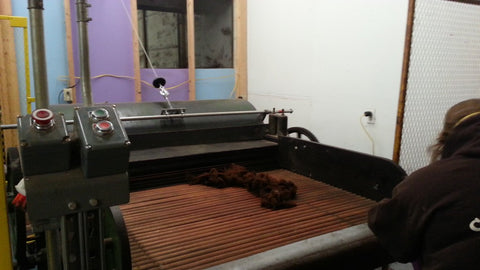
Feeding raw fiber into the picker

Fluffy Alpaca Fiber after going through the Picker
The clean fiber is then fed through a carder. The carder is a Davis Furber and is two machines hooked together. The front half was made in 1919 and the back half was made 1911. This is heavy duty machinery and Karen depends on her husband and son to keep this amazing system running smoothly. When parts occasionally fail Karen and her team need to fashion their own parts and repairs to keep the machines running. This mill is a piece of living history!
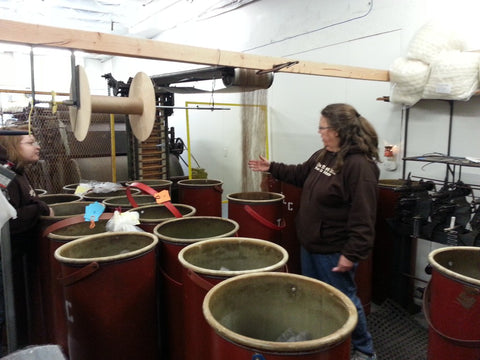
Combing the fiber
The pin drafter is a Warner and Swassey machine and is monitored closely while the fiber is fed through the process. The process is closely monitored by hand and each batch is kept separate in these barrels and tagged with the fiber type and animal's name.
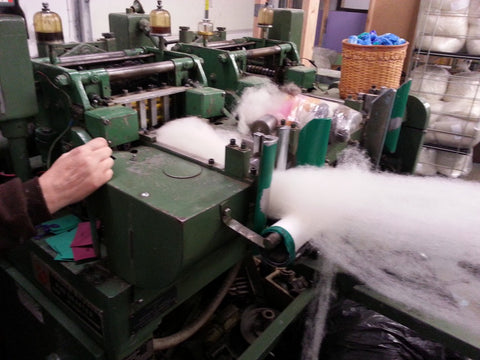
Feeding the pin drafter machine

Guiding roving as it comes out of the pin drafter
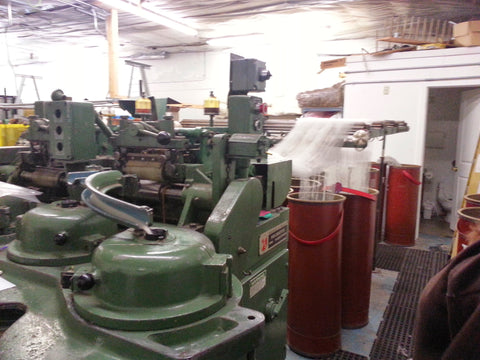

Pin Drafted Roving Ready To Be Spun
Once the yarn is pin drafted, the mill can spin it into yarn.
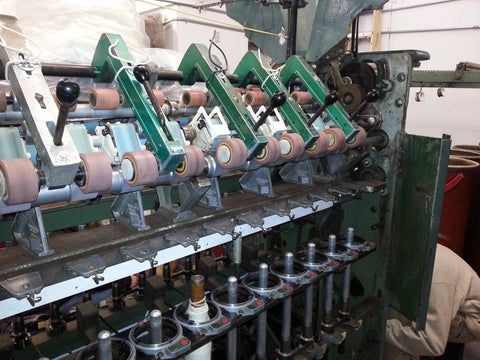
Spinning machine making yarn

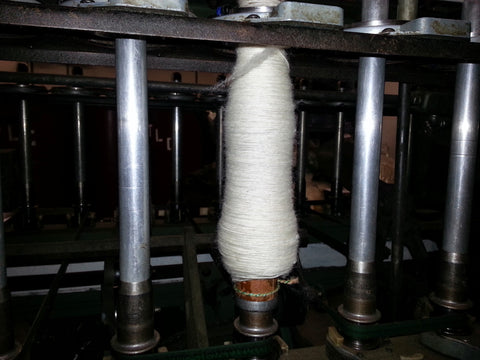
Spinning yarn onto a spindle
With our fleece we chose to stop the process at the roving stage to allow handspinners the opportunity to spin the fiber into the yarn of their choice. Through the entire process we keep each animal's fleece separate so the roving carries the unique qualities of the specific alpaca for that year. When our customers purchase the roving, we can provide a photo of the animal so they can see where the roving originated. Often times our customers will create a unique handmade scarf or sweater and include a picture of the alpaca when presenting it has a gift.
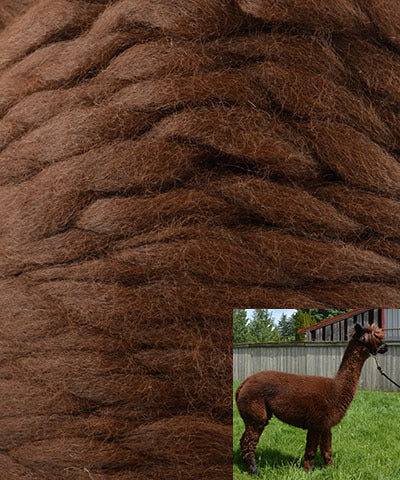
Annabelle Roving

Boomer Roving
This is an amazing opportunity to grow fiber, process it locally and the end product can proudly be labeled "Grown and processed in Northern Idaho, USA". We are so pleased to offer these beautiful, luxurious alpaca rovings on a limited availability basis. Each alpaca is sheared just once per year, so the supply is limited. If you see something you just can't wait to spin...better get it quickly!
October 05, 2016
Thank you for the fabulous insight! Very interesting. I love the old machines.
October 05, 2016
I love the personal touch of having the alpaca’s name with the roving. I know these animals are treated well and that makes me a happy customer.
October 05, 2016
Thank you for this wonderful information. What a great idea to bring us knitters and crocheters closer to the environment and processing of the fibers.
Comments will be approved before showing up.

by Meg Bateman January 02, 2022 1 min read
Do you feel lost when it comes to picking out your first knit sweater pattern? This week, Kelley shared her favorite sweater patterns during Technique Tuesday. These patterns all feature minimal seaming, have detailed instructions, and have lots of completed projects on Ravelry!
Kelley has knit the Brick Sweater several times, and has decided to knit it again with all our Technique Tuesday viewers! Grab some worsted weight yarn and join us for this informal knit along.

by Meg Bateman January 02, 2022 1 min read

by Meg Bateman January 02, 2022 1 min read
Sign up to get the latest on sales, new releases and more …
Lynette Tom
October 05, 2016
My daughter lives in Nashville and dyes fiber and yarn for a mill and I’m so excited for her. She loves doing it and we want to go see her when the mill is open so we can watch the action. It is really fascinating to hear her tell about it. We live in Northwest Ohio.